It's all about the classical music composers and their works from the last 400 years and much more about music. Hier erfahren Sie alles über die klassischen Komponisten und ihre Meisterwerke der letzten vierhundert Jahre und vieles mehr über Klassische Musik.
Total Pageviews
Friday, December 20, 2024
Listen to the Best of Baroque Music This Christmas!
by Hermione Lai, Interlude

There is no better way to celebrate the holiday season than to listen to joyful and uplifting Baroque music. For me, it’s the best and most inspiring classical Christmas music, and it includes Messiah by Handel, the beautiful Christmas Oratorio by J.S. Bach, the pastoral Christmas Concerto by Arcangelo Corelli, and the emotional Christmas Cantata by Alessandro Stradella. Why not listen with me to the best of Baroque music this Christmas?

A Performance of Handel’s Messiah © shepherdexpress.com
We all know that George Frideric Handel (1685-1759) was one of the all-time great composers. And around Christmas you can hear his popular oratorio Messiah wherever you go. Handel actually composed the piece in the middle of severe financial difficulties; and then he had a brilliant idea. He talked to the clergyman Charles Jennens about a text on the Messiah combining verses from the King James Bible. The finished text was very long, and it is subdivided into three parts. First is the Prophecy of the Messiah, followed by the Passion and Redemption of Christ, and finally a hymn of Thanksgiving. Handel composed all the music in about three weeks. There are recitatives, arias and large choruses, and this monument of Baroque music has easily become one of the composer’s most popular and enduring works. Only the first part of the Messiah deals with Christmas. There is a majestic instrumental “Sinfonia,” and the reassurance of Christ’s birth is expressed in the beautiful recitative “Comfort ye, my people.” This is followed by the virtuoso aria “Ev’re valley” and the magnificent chorus “And the glory of the Lord.” Another chorus “And he shall purify” is followed by a magnificent alto aria, with the chorus joining to rejoice in Christ’s birth. The joy of the occasion is jubilantly extended in the fast choral section “For unto us a child is born.” The Christmas story always tells of shepherds, and the instrumental “Pifa” makes reference to the serenity of a rural setting. “There were Shepherds” is part of a brilliantly orchestrated accompanied recitative “And lo, the Angel of the Lord.” The music and text go back and forth between telling us the Christmas story, and showing us the feelings of the characters. “And the Angel said unto them” is answered by the chorus exclaiming the majestic hymn “Glory to God in the highest.” There is another beautiful operatic aria “Rejoice greatly,” followed by the recitative “Then shall the eyes of the blind.” The gorgeous alto melody “He shall feed his flock” is reused in “Come unto him” by the soprano. The first part of this Baroque masterpiece ends with the choral scene “His yoke is easy.” Maybe you have already figured out that the famous “Hallelujah Chorus” is not part of the Christmas story. But that’s probably not really important, as the uplifting music and message is perfect for a festive holiday season.
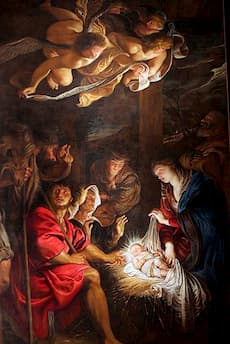
Adoration of the Shepherds by Peter Paul Rubens
© Wikipedia
One of the top pieces of classical Christmas music is J.S. Bach’s Christmas Oratorio. But it’s actually more than one composition. Bach was working in Leipzig, and part of his job was to compose music for the two main churches of the city, St. Thomas and St. Nicholas. Christmas season in Leipzig was celebrated in Leipzig from Christmas Day through Epiphany. Epiphany is all about the adoration of the Magi and the Flight into Egypt, and it is celebrated on January 6th. Bach needed to compose a cantata each for the six feast days of Christmas. The first three cantatas celebrate the first three days of Christmas, then comes New Year, the Sunday after New Year, and Epiphany. On 26 December 1734 Leipzig heard the first cantata describing the annunciation to the shepherds, in which an angel tell a group of shepherds about the birth of Jesus. Of course, the shepherds are all terrified but the angel explains “Today in the town of David a Savior has been born to you; he is the Messiah, the Lord. This will be a sign to you. You will find a baby wrapped in cloths lying in a manger.” A great many more angles come and sing praise to God, and so the shepherds travel to Bethlehem and find Mary and Joseph and the infant Jesus. In 1734 Bach was at the height of his compositional powers, and he created a wondrously dramatic and celebratory work. Passages from the bible are assigned to the tenor evangelist, who musically recites the text. A large chorus sings the response of the congregation, and also the praise and thanksgiving for the Christmas message. And then we have the most gorgeous Baroque arias that allow for further reflection. You can hear in every tone the joy of the season, and Bach added trumpets and timpani to make the music even more festive. Bach’s Christmas Oratorio is another monument of Baroque music and one of the most wonderful pieces of classical Christmas music.
 Some of the best Baroque music for Christmas is connected to some really interesting characters and stories. Take for example the Cardinal Pietro Ottoboni, a man sworn to celibacy by the church. But the Cardinal had other ideas, as he loved pomp and sensual pleasure. Nobody knows how many mistresses wandered through the Cardinal’s bedroom, but rumors suggested that he had between 60 and 70 children. The Cardinal was also a lover of the arts and specifically music, and he constructed himself a theatre. He also wrote his own opera and oratorio texts, and asked various composers to set them to music. Ottoboni was surely a major eccentric, and he surrounded himself with an extended circle of queer artists. He thought that being queer made artists more creative, and among his hires was the violinist and composer Arcangelo Corelli (1653-1713). Corelli and his lover Matteo Fornari soon became the star attractions as they came up with a new kind of music, which they called “concerto.” All that means is that a bigger orchestra contrasts a small group of performers or soloists. Maybe the Cardinal Ottoboni asked Corelli to compose him a “Christmas Concerto.” Nobody knows if that was actually the case, but the last movement has a beautiful pastoral quality. When Antonio Vivaldi first heard this piece he excitedly wrote, “Concerto, fatto per la note di natale” (Concerto composed for Christmas Eve.) It is one of the most touching Baroque instrumental pieces for Christmas, and a wonderful way to say Merry Christmas musically.
Some of the best Baroque music for Christmas is connected to some really interesting characters and stories. Take for example the Cardinal Pietro Ottoboni, a man sworn to celibacy by the church. But the Cardinal had other ideas, as he loved pomp and sensual pleasure. Nobody knows how many mistresses wandered through the Cardinal’s bedroom, but rumors suggested that he had between 60 and 70 children. The Cardinal was also a lover of the arts and specifically music, and he constructed himself a theatre. He also wrote his own opera and oratorio texts, and asked various composers to set them to music. Ottoboni was surely a major eccentric, and he surrounded himself with an extended circle of queer artists. He thought that being queer made artists more creative, and among his hires was the violinist and composer Arcangelo Corelli (1653-1713). Corelli and his lover Matteo Fornari soon became the star attractions as they came up with a new kind of music, which they called “concerto.” All that means is that a bigger orchestra contrasts a small group of performers or soloists. Maybe the Cardinal Ottoboni asked Corelli to compose him a “Christmas Concerto.” Nobody knows if that was actually the case, but the last movement has a beautiful pastoral quality. When Antonio Vivaldi first heard this piece he excitedly wrote, “Concerto, fatto per la note di natale” (Concerto composed for Christmas Eve.) It is one of the most touching Baroque instrumental pieces for Christmas, and a wonderful way to say Merry Christmas musically.
 For the final selection of the best Baroque music for Christmas, I have selected the Christmas Cantata by Alessandro Stradella (1643-1682). He was one of the most versatile and lively Italian composers in his day. He enjoyed a colorful and dazzling career as a freelance composer who managed to make countless enemies along the way. He tried to embezzle money from the Roman Catholic Church, and he had a weak spot for married women or the mistresses of the powerful and mighty. One evening while walking away from a little encounter, two assassins attacked him. By sheer luck he managed to survive the attack, but he was not that lucky a couple of years later when his life was tragically ended at the age of 42. A shadowy assassin stabbed him to death, having been hired by a jealous husband. Stradella was a highly sought after composer and none of his personal scandals affected the demand for his music. A group of wealthy patrons even provided him with a house, food, and a servant in addition to a generous yearly stipend. And we can certainly hear Stradella’s passion in his Christmas Cantata, first heard on Christmas Eve. Just listen to the beautiful pastoral atmosphere throughout the piece. There is no fake theatre, but just an emotional prayer from the Virgin Mary to her son. I guess we can all use a prayer during these unsettling times, and wherever you are in the world, may the best of Baroque Christmas music lift your spirits.
For the final selection of the best Baroque music for Christmas, I have selected the Christmas Cantata by Alessandro Stradella (1643-1682). He was one of the most versatile and lively Italian composers in his day. He enjoyed a colorful and dazzling career as a freelance composer who managed to make countless enemies along the way. He tried to embezzle money from the Roman Catholic Church, and he had a weak spot for married women or the mistresses of the powerful and mighty. One evening while walking away from a little encounter, two assassins attacked him. By sheer luck he managed to survive the attack, but he was not that lucky a couple of years later when his life was tragically ended at the age of 42. A shadowy assassin stabbed him to death, having been hired by a jealous husband. Stradella was a highly sought after composer and none of his personal scandals affected the demand for his music. A group of wealthy patrons even provided him with a house, food, and a servant in addition to a generous yearly stipend. And we can certainly hear Stradella’s passion in his Christmas Cantata, first heard on Christmas Eve. Just listen to the beautiful pastoral atmosphere throughout the piece. There is no fake theatre, but just an emotional prayer from the Virgin Mary to her son. I guess we can all use a prayer during these unsettling times, and wherever you are in the world, may the best of Baroque Christmas music lift your spirits.
Ludwig van Beethoven: A “Bagatelle” Tribute
by Georg Predota
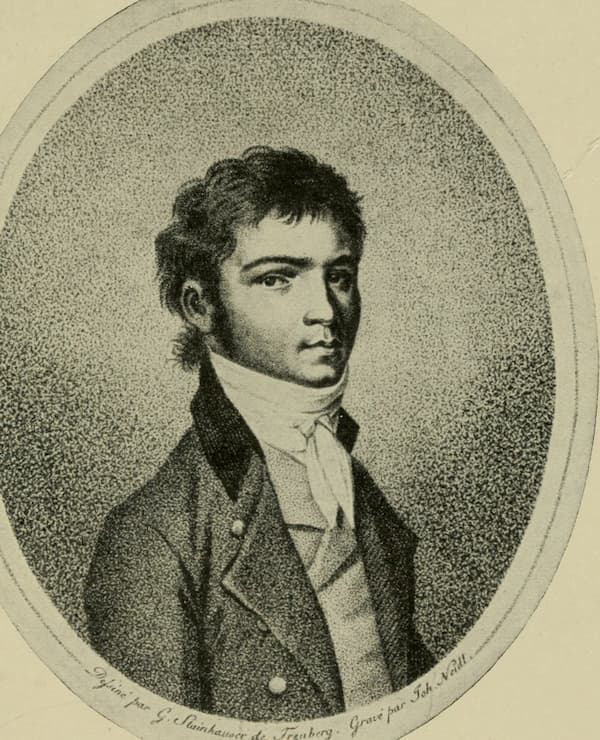
Ludwig van Beethoven at 26 years old
However, virtuosity is all but one aspect of Beethoven’s piano repertoire, as he was able to compose music with “glowing passion, exuberance, heroism, nobility and dramatic pathos.” His 32 piano sonatas and the late variation sets are at the pinnacle of piano literature, but Beethoven also composed three sets of what he titled “Bagatelles.”
That particular title implies no specific form, and Beethoven himself called the first six of his Op. 119 “Kleinigkeiten,” or trifles. So, just how serious are these Bagatelles? Well, some of the bagatelles were originally planned as movements for piano sonatas but were subsequently rejected by Beethoven before publication. This seems to suggest that some of the bagatelles, as potential sonata movements, are the compositional equal to sonata movements in quality and completeness.

Beethoven’s house of birth in Bonn, 2008
One thing for sure, the bagatelles are a series of short and sometimes light-hearted piano works in a variety of contrasting characters and moods. It’s hardly surprising that some scholars consider Beethoven’s bagatelles to be the first 19th-century character pieces. To celebrate Beethoven’s baptism on 17 December, let us briefly explore his Bagatelles Op. 33, Op. 119, and Op. 126.
Bagatelles Op. 33
The first of Beethoven’s three published sets of Bagatelles was issued in 1803 by Bureau d’Arts et d’Industrie. The surviving sketches and the nature of the music suggest that Beethoven simply compiled a number of separate pieces that originated anywhere between boyhood and the start of the new century. All 7 Bagatelles display conventional musical forms and styles, and most are written in three-part form.
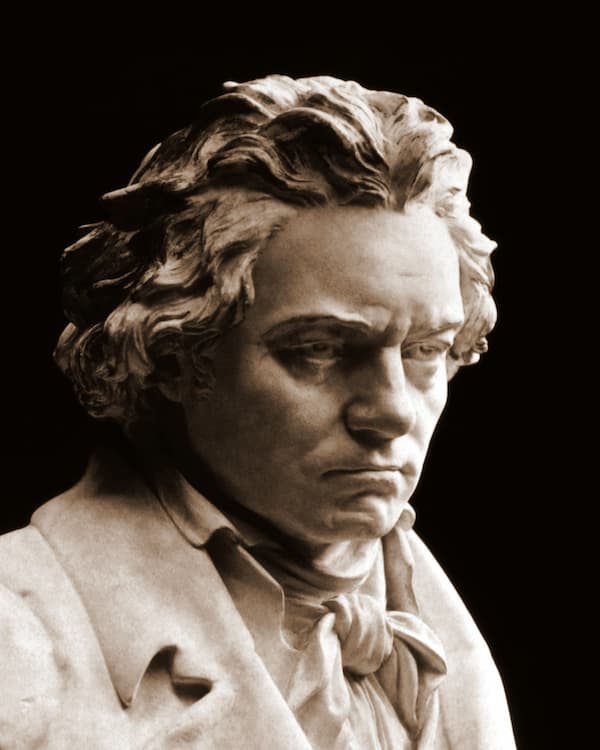
Photograph of bust statue of Ludwig van Beethoven by Hugo Hagen
Beethoven thoroughly revised his Bagatelles shortly before publication. At the same time, however, he was incredibly busy and worked on his Piano Concerto No. 3, the Symphony No. 2 and the oratorio “Christ on the Mount of Olives.” We still don’t know exactly why Beethoven devoted so much time to the Bagatelles, but Paul Lewis suggests that “in light of Beethoven’s rising fame, it was to satisfy a growing demand from students and amateurs for easy pieces from his pen.”
We find a simple and innocent tune in No. 1, garnished with plenty of ornamentation and light-hearted transitions. No. 2 has the character of a scherzo that humorously manipulates rhythm and accents, while No. 3 appears folk-like in its melody and features a delicious change of key in the second phrase. The A-Major Bagatelle No. 4 is essentially a parody of a musette with a stationary bass pedal, and the minor-mode central section offers harmonic variety.
Beethoven provides some musical humour in No. 5 as this playful piece is a parody of dull passagework. In a really funny moment, the music gets stuck on a single note repeated over and over, like Beethoven can’t decide what to do next. In the end, he decides to repeat what he has already written before. In No. 6, we find a tune of conflicting characters, with the first phrase being lyrical and the second phrase being tuneful. The beginning of No. 7 almost suggests Beethoven’s Waldstein Sonata.
Bagatelles Op. 119
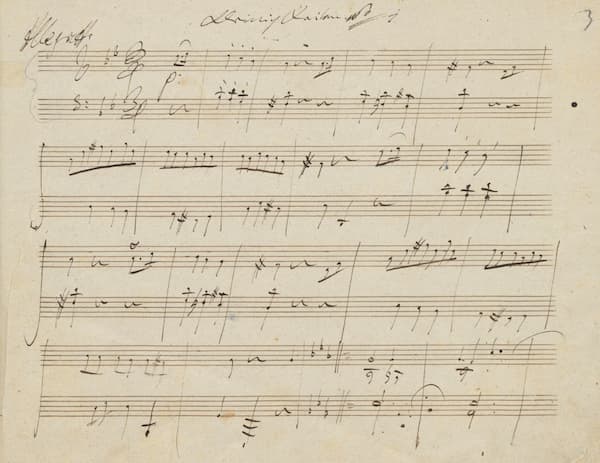
Beethoven’s Bagatelles Op. 119 No. 1 manuscript
In 1823, Beethoven was finishing his late piano sonatas Op. 109, 110, and 111, and he was working on the Diabelli Variations and the Missa Solemnis. In that year, he wrote to Ferdinand Ries in London, “you are receiving six bagatelles or trifles, and again another five, which belong together, in two parts. Dispose of them as favourably as you can.” Ries sold the set to the London publisher Clementi, who issued all eleven pieces in 1823. This edition is titled “Trifles for the Piano Forte, consisting of eleven pleasing pieces composed in various styles.”
Essentially, in Beethoven’s Op. 119, we are dealing with two different collections combining old and new works. The set builds on five miniatures, which Beethoven composed in 1820 for the third and final volume of Friedrich Starke’s Wiener Piano-Forte-Schule (Viennese School of Piano Playing). Eventually, these 5 bagatelles became Nos 7-11 of Op. 119. Nos 1-5 had already been completed, or possibly sketched, much earlier and dated from around 1800. The central bagatelle in this set was the last to be composed, probably in late 1822, shortly before publication.
In the 1820s, Beethoven’s Leipzig publisher Carl Friedrich Peters was initially interested in publishing the first bagatelles but later emphatically rejected them as he wrote to Beethoven, “I’ve had them played by several people, and not one of them will believe me that they are by you. I asked for “Kleinigkeiten,” but these are really too small… I will say no more about it, other than that I will never print these but will rather lose the fee I have already paid.” And he added, “the pieces are not worth the money, and you should consider it beneath your dignity to waste time with such trivia that anyone can write.”
However, in Beethoven’s mind these miniatures were by no means inferior to his more extended piano works but “were simply ideas that were complete in themselves.” He actually enjoyed writing these little pieces, and he highly valued his “trifles.” Imogen Cooper writes, “Op. 119 form a compendium of technique and piano texture in concise form, as is appropriate for a piano tutor.” We may add, however, that Beethoven may not have always had the amateur performer in mind, given the technical challenges written into some of these “Kleinigkeiten.”
No. 1 presents a rather nostalgic opening, while a busy No. 2 unfolds with triplets surrounding the theme in the right hand. Written in the style of an Allemande, No. 3 promises a point of reflection, but it is interrupted by the opening waltz. A lyrical No. 4 is juxtaposed by an almost pompous No. 5, and No. 6 is the most varied and developed. Trills dominate No. 7, while a tranquil No. 8 features some intriguing harmonic progressions.
No. 9 unfolds in the character of a Ländler and features heavily accented syncopation. No. 10 is noteworthy because of its extreme brevity. Lasting only a few seconds and fitting into a single system of printed music, it is Beethoven’s shortest work, perhaps one of the shortest works of any composer of note. Finally, No. 11 rounds off the set in a mood of graceful contemplation.
Bagatelles Op. 126
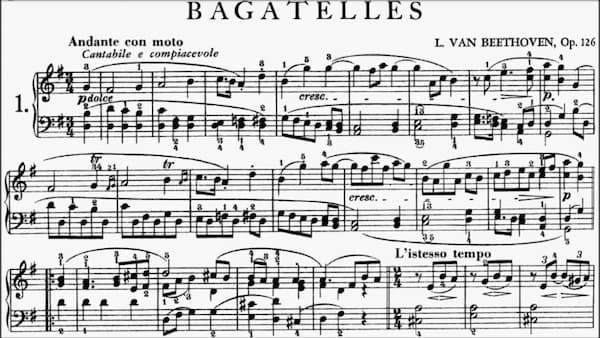
Beethoven’s Bagatelle Op. 126
When Beethoven offered the Bagatelles Op. 126 to the publishers Schott & Co. in November 1824, he described them as “6 Bagatelles or Trifles for solo piano, some of which are rather more developed and probably the best pieces of this kind I have written.” Contrary to his earlier Bagatelle settings, Op. 126 was conceived as an integral group of pieces which Beethoven labelled a “cycle of little pieces.”
Designed as a unified cycle from the outset, the Bagatelles are alternately lyrical and introspective, and fast and dramatic, “with the two threads drawn together in the final number; and their keys form a descending chain of thirds, beginning in G major and minor, and ending in E flat major.” And let us not forget that Op. 126 was Beethoven’s last work for the piano offering a concentration of musical thoughts typical of his late style.
As Paul Lewis writes, “Typical of that style is a native fluency in contrapuntal writing paired with freedom from formal constraints in applying it, along with a willingness to write his contrapuntal voices several octaves apart. Beethoven, the architect of massive, great formal structures, shows himself in these pieces as a master of the miniature, deftly creating an immediate impression with his opening gestures and developing his motives with unfettered originality.”
Beethoven treats his material with a great deal of freedom, transforming it through intricate ornamentation as in No. 1. Full of driving energy, No. 2 channels the music into playful directions while the noble simplicity of No. 3 is sustained through many changes in texture. The contrapuntal opening of No. 4 is contrasted by a dream-like section, with plenty of unexpected harmonic and mood changes.
The quietly expressive No. 5 creates a gentle flow with triplet patterns and subtle syncopations, while No. 6 starts and ends with an energetic, turbulent section, framing a central, more composed segment that begins like a barcarolle. The opening Presto dismisses the slower section and the piece ends abruptly. As a commentator wrote, it ends “almost if dismissing the introspective nature of the preceding music; a fitting way for Beethoven to conclude his piano compositions.”
In terms of compositional style, the Bagatelles are comparable to the late string quartets, particularly with the second movement of Op. 132. And to be sure, the relationship between the late bagatelles and Beethoven’s late period works has been the subject of various studies. It uses the same musical language but “offers a musical universe in just a couple of minutes.”
Stylistically, the late Bagatelles looked forward to the foundations of romanticism as the expression of personal emotions became increasingly important. To some observers, Beethoven’s late Bagatelles are the first character pieces, a genre that gained unprecedented prominence later in the century. As Maurice Hinson suggests, “Beethoven’s Op. 126 are, if anything in music can be, self-portraits, as they express his moods and frame of mind the day he composed them.”
As you might have expected, we can’t really talk about Beethoven Bagatelles without mentioning the Bagatelle in A minor, WoO 59. One of the most popular short pieces by the composer, this Bagatelle goes by the nickname “Für Elise.” Probably composed around 1810, it was reworked in the early 1820s. It was first published only in 1867, four decades after the composer’s death, in an appendix to a collection of Beethoven letters and hitherto unknown works.
The inscription “Für Elise” remains a mystery, and various theories suggest young women in or around Beethoven’s circle. The distinctive theme with the repeated neighbour-note is supported by arpeggiated chords shared between the hands. As a scholar reports, in some of the sketches from the early 1820s, Beethoven contemplated “a somewhat more sophisticated layout of the arpeggios, but these did not find their way into a definite version of the work.”
The Beethoven Bagatelles offer a diverse and evolving body of work, displaying the composer’s creative exploration in this genre of short and expressive piano pieces. They evolved from playful themes and structure to pieces of greater sophistication by blending dense harmonic landscapes with sudden shifts in mood, texture, and rhythm.
“The Little Drummer Boy”
10 Beautiful versions for Christmas
By Hermione Lai
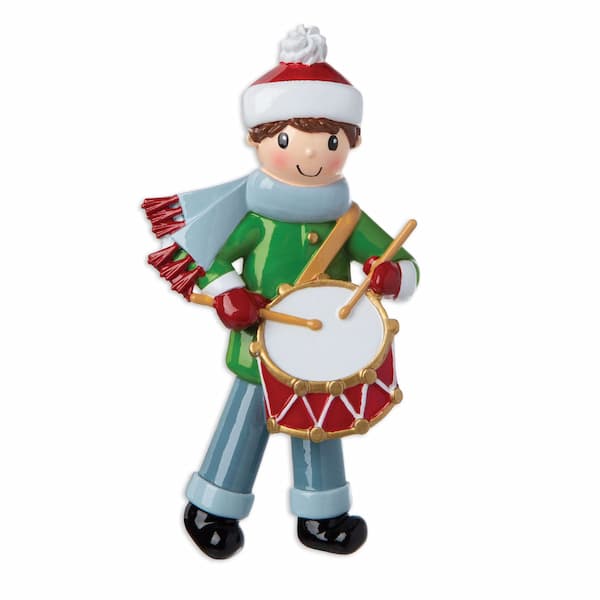
The Little Drummer Boy ornament
One of the most beloved and enduring Christmas carols is “The Little Drummer Boy.” It is a heartwarming and simple story about a poor boy who offers the gift of music to the newborn Jesus. Evoking a sense of humility, innocence, and devotion, it’s no wonder that it is a favourite during the holiday season. With Christmas once again around the corner, I wanted to share 10 beautiful versions of this delightful and touching carol with you.
“The Little Drummer Boy” The Harry Simeone Chorale (1965)
Katherine Kennicott Davis
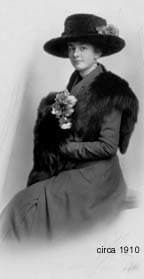
Katherine Kennicott Davis
To me, this lovely Christmas carol initially sounded like an ancient melody, but I was wrong. It was written only in 1941 by the American composer Katherine Kennicott Davis. David studied music at the New England Conservatory of Music in Boston, and also with Nadia Boulanger in Paris. She taught music at two Schools for Girls in Massachusetts and in Philadelphia.
For the choirs at her schools, Davis composed well over 600 compositions, and she also contributed to a multiple-volume set of music and books for educational purposes. Much of her music was published by Schirmer in Boston. Davis left all of the royalties and proceeds from her compositions to Wellesley College’s Music Department, her alma mater, where she studied in her youth.
“The Little Drummer Boy” Bing Crosby/David Bowie (1977)
Marching Rhythm
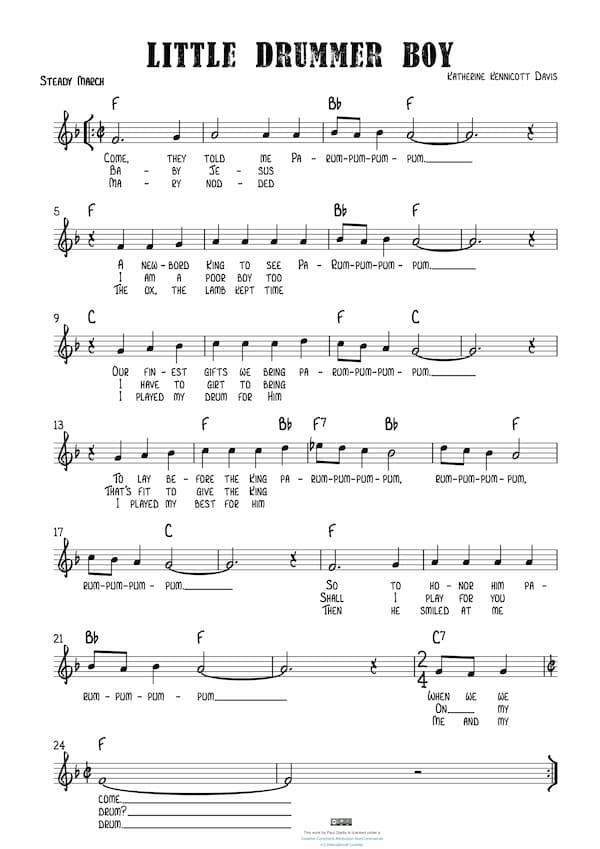
The Little Drummer Boy music score
One of the most prominent features of this beloved Christmas carol is the rhythm. And you can hear how it plays a role in telling the song’s simple and heartfelt message. It’s almost military-like, and while the basic 4/4 rhythm is straightforward, there are moments of syncopation in the vocal line. The steady drumming beat is both humble and profound.
Davis originally called the song “Carol of the Drums,” and she might have suggested that it is based on a Czech carol. However, the chair of the music department at Wellesley College writes. “One day, when Davis was trying to take a nap, she was obsessed with this song that came into her head, and it was supposed to have been inspired by the French song “Patapan.” ‘Patapan’ translated in her mind to ‘pa-rum-pum-pum,’ and it took on a rhythm.”
“The Little Drummer Boy” Celtic Woman
Lyrics
The text of this wonderful carol centres on the themes of humility, generosity, and sacrifice. The narrator is a poor boy who offers the newborn King his musical talent and drumming skills. In a way, the act of giving something of personal value rather than material wealth is a fundamental Christian idea rooted in love and devotion.
Verse 1
Come, they told me
Pa-rum pum pum pum
A newborn King to see
Pa-rum pum pum pum
Our finest gifts we bring
Pa-rum pum pum pum
To lay before the King
Pa-rum pum pum pum
Rum pum pum pum, rum pum pum pum
“The Little Drummer Boy” Pentatonix (2014)
Refrain
Refrain
So to honour Him
Pa-rum pum pum pum
When we come.
The recurring “pa-rum pum pum pum” serves both as a musical refrain and a symbolic gesture. It reflects the sound of a drum, and the repeated drumbeats communicate a sense of ritual and prayer. We might even hear the drumbeat as a metaphor for the boy’s heart beating in rhythm with his faith and his desire to honour Jesus. It also becomes a symbol of unity and community as the boy’s humble gift is part of a universal offering of love.
“The Little Drummer Boy” Thom Hell/Ulvo Andreas (2020)
Second Verse
Second Verse
Little baby, pa-rum pum pum pum
I am a poor boy too, pa-rum pum pum pum
I have no gift to bring, pa-rum pum pum pum
That’s fit to give a King, pa-rum pum pum pum
Rum pum pum pum, rum pum pum pum.
Shall I play for you, pa-rum pum pum pum
On my drum?
In the second verse the poor boy is directly addressing the newborn Jesus Christ. The lines take on an almost lullaby-like quality. As the boy identifies himself as poor, he establishes a connection between them, as both are humble. The boy acknowledges that he has no valuables or conventional gifts, and by recognising his poverty, the boy also becomes vulnerable. He does offer something more valuable than material riches, and that’s the gift of music.
“The Little Drummer Boy” André Rieu/Mik Falize (2023)
Third Verse
Third Verse
Mary nodded
Pa-rum pum pum pum
The ox and lamb kept time
Pa-rum pum pum pum
I played my drum for Him
Pa-rum pum pum pum
I played my best for Him
Pa-rum pum pum pum
Rum pum pum pum, rum pum pum pum
Then He smiled at me, Pa rum pum pum pum
Me and my drum.
The final verse continues with the sentiments introduced in the previous two. The boy’s humble gift of drumming is accepted and acknowledged by Mary, and even the animals, who keep time, participate in the sacred moment. The boy offers his sincere devotion, and we understand that true worship comes from the heart.
“The Little Drummer Boy” Jackson 5 (1970)
The Hit
Initially, “The Carol of the Drum” was not really popular. Remember, it was written during World War II and the public preferred songs like “I’ll be Home for Christmas.” The famous Trapp Family Singers recorded a version in 1951, which provided some exposure. However, it wasn’t until 1958 that “The Carol of the Drum” became an instant hit. At that time, a famous orchestra and choir director, Harry Simeone, got hold of the song.
For one, he renamed the song “The Little Drummer Boy,” and blended voices to create a drum beat. For added effect, he also added finger cymbals. The album and song were an enormous success, “with the single scoring in the top 40 of the U.S. music charts from 1958 to 1962.” But Simeone wasn’t alone, as by 1962, the carol had been recorded more than a hundred times. By the end of that decade, only two other Christmas songs had generated more success, “White Christmas” and “Rudolph the Red-Nosed Reindeer.”
“The Little Drummer Boy” Tori Amos (2007)
Merry Christmas
“The Little Drummer Boy” is one of those Christmas carols that transcends generations. Its universal message of giving, humility, and love resonates with people of all ages and backgrounds, and it continues to be a Christmas favourite year after year. Every year, we welcome new recordings, and the cello version by Hauser is brand-new, dating from November 2024.
“The Little Drummer Boy” Hauser (2024)
It is not a biblical story, but the song holds a special place in Christmas music history due to its gentle reminder that Christmas is not just about wealth or material gifts but about the simple, heartfelt offering of one’s talents, love, and devotion. Whether performed in churches, homes, or concerts, “The Little Drummer Boy” continues to inspire and bring joy to listeners worldwide during the holiday season. We wish you happy and peaceful holidays.
Thursday, December 19, 2024
Casablanca 1942 - As Time Goes By (original song Dooley Wilson)
- and indeed, the first screenings brought a solid, but not spectacular success. It was considered to be one of dozens of run-of-the-mill films churned out in Hollywood every year . The film was quickly released to take advantage of the resonance surrounding the Casablanca Conference of the Allies and the landing of troops in North Africa , which took place a few weeks before the film's premiere and was still fresh in the minds of audiences.